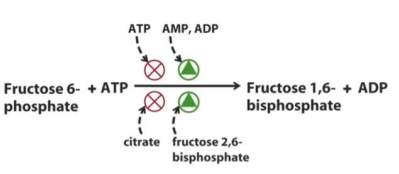Glycolysis And Pentose Phosphate
Glycolysis steps
| Step | Reactant | Product | Enzyme | dG (kJ/mol) | Notes |
|---|---|---|---|---|---|
| 1 | glucose | glucose-6-phosphate (G6P) | Hexokinase | -20.9 | Irreversible (ATP consumed) |
| 2 | G6P | Fructose-6-P (F6P) | Phosphohexose isomerase | 2.2 | |
| 3 | F6P | fructose 1,6-bisphosphate (F1,6BP) | Phosphofructokinase-1 (PFK-1) | -17.2 | Irreversible (ATP consumed). This step guarantees the sugar will proceed down glycolysis. Alternatively, G6P may have been shuttled to other pathways. |
| 4a | F1,6BP | glyceraldehyde 3-phosphate (GAP) & dihydroxyacetone phosphate (DHAP) | Aldolase | 22.8 | Reversible. GAP and DHAP concentration generally remain low |
| 4b | DHAP | GAP | Triose Phosphate Isomerase | 7.9 | Only GAP can be used in step 6, so DHAP has to be converted |
| 5 | GAP, NAD+ | 1,3-bisphosphoglycerate (1,3-BPG), NADH | Glyceraldehyde 3-phosphate dehydrogenase | 12.2 | |
| 6 | 1,3-BPG, ADP | 3-phosphoglycerate, ATP | Phosphoglycerate kinase | -18.5 | 1 ATP is generated per GAP, so we are now net 0 energy wise |
| 7 | NOT IMPORTANT | ||||
| 8 | NOT IMPORTANT | ||||
| 9 | Phosphoenolpyruvate, ADP | Pyruvate, ATP | Pyruvate kinase | -31.4 | Irreversible |
Changes:
- 2 ADP + 2 Pi → 2 ATP
- Glucose → 2 Pyruvate
- 2 NAD+ → 2NADH
- Also produces 2 H+, 2 H2O
Pyruvate is sent to PDC and Krebs (TCA).
Regulators of PFK-1
Step 3 is the rate limiting step of glycolysis.
Inhibitors: ATP, Pyruvate (via citrate from oxidative phosphorylation)
Activators: AMP/ADP, F2,6BP, stimulated by glucagon

Pentose phosphate pathway
PPP reduces NADP+ to NADPH+ (occurs twice) and produce ribose 5-phosphate which is used to make DNA/RNA. High NADPH relative to NADP+ will drive the biosynthesis of fatty acids and nucleotides.
Oxidative phase: NADP+ is reduced (twice) to NADPH
Non-oxidative phase: Rebuild a 6-carbon molecule from the 5-carbon form if it isn't used to make ribose 5-phosphate
NADPH is important in radical cell defense
Reduced glutathione will use its unpaired S-H from cystine to match the unpaired electron in a reactive oxygen species (ROS) which would otherwise harm the cell. NADPH will reduce glutathione for this purpose.
Clinical pearl: Favism
For people with a G6P deficiency, the PPP cannot produce NADPH. Because red blood cells do not have mitochondria for making oxaloacetate which would otherwise converted to extra NADPH, ROSs represent a serious threat.
People with Favism require supplementation with Glucose-6-phosphate dehydrogenase (G6PDH).